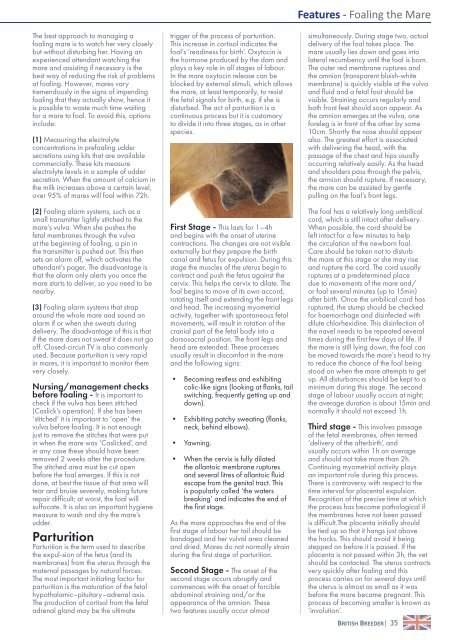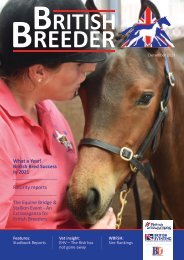British Breeder Magazine May 2021
Create successful ePaper yourself
Turn your PDF publications into a flip-book with our unique Google optimized e-Paper software.
The best approach to managing a<br />
foaling mare is to watch her very closely<br />
but without disturbing her. Having an<br />
experienced attendant watching the<br />
mare and assisting if necessary is the<br />
best way of reducing the risk of problems<br />
at foaling. However, mares vary<br />
tremendously in the signs of impending<br />
foaling that they actually show, hence it<br />
is possible to waste much time waiting<br />
for a mare to foal. To avoid this, options<br />
include:<br />
(1) Measuring the electrolyte<br />
concentrations in prefoaling udder<br />
secretions using kits that are available<br />
commercially. These kits measure<br />
electrolyte levels in a sample of udder<br />
secretion. When the amount of calcium in<br />
the milk increases above a certain level,<br />
over 95% of mares will foal within 72h.<br />
(2) Foaling alarm systems, such as a<br />
small transmitter lightly stitched to the<br />
mare’s vulva. When she pushes the<br />
fetal membranes through the vulva<br />
at the beginning of foaling, a pin in<br />
the transmitter is pushed out. This then<br />
sets an alarm off, which activates the<br />
attendant’s pager. The disadvantage is<br />
that the alarm only alerts you once the<br />
mare starts to deliver, so you need to be<br />
nearby.<br />
(3) Foaling alarm systems that strap<br />
around the whole mare and sound an<br />
alarm if or when she sweats during<br />
delivery. The disadvantage of this is that<br />
if the mare does not sweat it does not go<br />
off. Closed-circuit TV is also commonly<br />
used. Because parturition is very rapid<br />
in mares, it is important to monitor them<br />
very closely.<br />
Nursing/management checks<br />
before foaling - It is important to<br />
check if the vulva has been stitched<br />
(Caslick’s operation). If she has been<br />
‘stitched’ it is important to ‘open’ the<br />
vulva before foaling. It is not enough<br />
just to remove the stitches that were put<br />
in when the mare was ‘Caslicked’, and<br />
in any case these should have been<br />
removed 2 weeks after the procedure.<br />
The stitched area must be cut open<br />
before the foal emerges. If this is not<br />
done, at best the tissue of that area will<br />
tear and bruise severely, making future<br />
repair difficult; at worst, the foal will<br />
suffocate. It is also an important hygiene<br />
measure to wash and dry the mare’s<br />
udder.<br />
Parturition<br />
Parturition is the term used to describe<br />
the expul-sion of the fetus (and its<br />
membranes) from the uterus through the<br />
maternal passages by natural forces.<br />
The most important initiating factor for<br />
parturition is the maturation of the fetal<br />
hypothalamic–pituitary–adrenal axis.<br />
The production of cortisol from the fetal<br />
adrenal gland may be the ultimate<br />
trigger of the process of parturition.<br />
This increase in cortisol indicates the<br />
foal’s ‘readiness for birth’. Oxytocin is<br />
the hormone produced by the dam and<br />
plays a key role in all stages of labour.<br />
In the mare oxytocin release can be<br />
blocked by external stimuli, which allows<br />
the mare, at least temporarily, to resist<br />
the fetal signals for birth, e.g. if she is<br />
disturbed. The act of parturition is a<br />
continuous process but it is customary<br />
to divide it into three stages, as in other<br />
species.<br />
First Stage - This lasts for 1–4h<br />
and begins with the onset of uterine<br />
contractions. The changes are not visible<br />
externally but they prepare the birth<br />
canal and fetus for expulsion. During this<br />
stage the muscles of the uterus begin to<br />
contract and push the fetus against the<br />
cervix. This helps the cervix to dilate. The<br />
foal begins to move of its own accord,<br />
rotating itself and extending the front legs<br />
and head. The increasing myometrial<br />
activity, together with spontaneous fetal<br />
movements, will result in rotation of the<br />
cranial part of the fetal body into a<br />
dorsosacral position. The front legs and<br />
head are extended. These processes<br />
usually result in discomfort in the mare<br />
and the following signs:<br />
• Becoming restless and exhibiting<br />
colic-like signs (looking at flanks, tail<br />
switching, frequently getting up and<br />
down).<br />
• Exhibiting patchy sweating (flanks,<br />
neck, behind elbows).<br />
• Yawning.<br />
• When the cervix is fully dilated<br />
the allantoic membrane ruptures<br />
and several litres of allantoic fluid<br />
escape from the genital tract. This<br />
is popularly called ‘the waters<br />
breaking’ and indicates the end of<br />
the first stage.<br />
As the mare approaches the end of the<br />
first stage of labour her tail should be<br />
bandaged and her vulval area cleaned<br />
and dried. Mares do not normally strain<br />
during the first stage of parturition.<br />
Second Stage - The onset of the<br />
second stage occurs abruptly and<br />
commences with the onset of forcible<br />
abdominal straining and/or the<br />
appearance of the amnion. These<br />
two features usually occur almost<br />
Features - Foaling the Mare<br />
simultaneously. During stage two, actual<br />
delivery of the foal takes place. The<br />
mare usually lies down and goes into<br />
lateral recumbency until the foal is born.<br />
The outer red membrane ruptures and<br />
the amnion (transparent bluish-white<br />
membrane) is quickly visible at the vulva<br />
and fluid and a fetal foot should be<br />
visible. Straining occurs regularly and<br />
both front feet should soon appear. As<br />
the amnion emerges at the vulva, one<br />
foreleg is in front of the other by some<br />
10cm. Shortly the nose should appear<br />
also. The greatest effort is associated<br />
with delivering the head, with the<br />
passage of the chest and hips usually<br />
occurring relatively easily. As the head<br />
and shoulders pass through the pelvis,<br />
the amnion should rupture. If necessary,<br />
the mare can be assisted by gentle<br />
pulling on the foal’s front legs.<br />
The foal has a relatively long umbilical<br />
cord, which is still intact after delivery.<br />
When possible, the cord should be<br />
left intact for a few minutes to help<br />
the circulation of the newborn foal.<br />
Care should be taken not to disturb<br />
the mare at this stage or she may rise<br />
and rupture the cord. The cord usually<br />
ruptures at a predetermined place<br />
due to movements of the mare and/<br />
or foal several minutes (up to 15min)<br />
after birth. Once the umbilical cord has<br />
ruptured, the stump should be checked<br />
for haemorrhage and disinfected with<br />
dilute chlorhexidine. This disinfection of<br />
the navel needs to be repeated several<br />
times during the first few days of life. If<br />
the mare is still lying down, the foal can<br />
be moved towards the mare’s head to try<br />
to reduce the chance of the foal being<br />
stood on when the mare attempts to get<br />
up. All disturbances should be kept to a<br />
minimum during this stage. The second<br />
stage of labour usually occurs at night;<br />
the average duration is about 15min and<br />
normally it should not exceed 1h.<br />
Third stage - This involves passage<br />
of the fetal membranes, often termed<br />
‘delivery of the afterbirth’, and<br />
usually occurs within 1h on average<br />
and should not take more than 2h.<br />
Continuing myometrial activity plays<br />
an important role during this process.<br />
There is controversy with respect to the<br />
time interval for placental expulsion.<br />
Recognition of the precise time at which<br />
the process has become pathological if<br />
the membranes have not been passed<br />
is difficult.The placenta initially should<br />
be tied up so that it hangs just above<br />
the hocks. This should avoid it being<br />
stepped on before it is passed. If the<br />
placenta is not passed within 3h, the vet<br />
should be contacted. The uterus contracts<br />
very quickly after foaling and this<br />
process carries on for several days until<br />
the uterus is almost as small as it was<br />
before the mare became pregnant. This<br />
process of becoming smaller is known as<br />
‘involution’.<br />
BRITISH BREEDER| 35















